August 30, 2019
Help prevent opioid abuse
Opioid use in the United States has reached crisis levels. According to data collected by the National Center for Health Statistics and the Centers for Disease Control and Prevention (CDC), the rate of opioid overdose deaths has been increasing since 1999.1 Approximately two million Americans are addicted to prescription opioids or heroin. Ninety-one people die from opioid overdoses every day. Opioids are effective at pain management — but they also carry significant risk.
Although death rates continue to increase, opioid prescribing trends since 2015 demonstrate a decrease in prescriptions dispensed. For instance, the 2017 Wisconsin Prescription Drug Monitoring Program Report showed –
- 20% decrease in opioid prescriptions dispensed
- 47% decrease in multiple prescriber / dispenser alerts
- 37% decrease in daily Morphine Milligram Equivalent dose greater than 90 alerts
- 30% decrease in opioid / benzodiazepine overlap
Data from Minnesota, Illinois and Iowa showed similar trends.
While this data is encouraging, more can be done to limit the risk of opioid misuse among patients.
When prescribing opioids, it is best practice to review the patient’s information on the state’s online Prescription Drug Monitoring Program (PDMP). Most states support this resource and many states require that providers review the PDMP before prescribing narcotics. It is also important to screen patients for opioid use history and risk factors for developing opioid use disorder.
Benefits don’t outweigh the risks
A recent analysis suggests the benefit of opioids may not outweigh the adverse effects for patients with noncancer pain. After reviewing 96 randomized controlled trials that included more than 26,000 noncancer patients, a statistically significant improvement in pain and physical functioning was found with opioid use. However, the incremental improvements were not clinically significant and resulted in an increase of adverse effects, especially vomiting.2
According to data from the CDC, more than 30% of opioid overdoses also involved benzodiazepines. Both classes of medication have a sedative effect and slow down the central nervous system. Combining these medications increases these effects and enhances the risk of opioid misuse and overdose. Extreme caution should be used in the rare instances when these medications are co-prescribed.
Dental procedures and opioids
Dental procedures, mainly wisdom teeth extractions, are a leading source of initial opioid exposure
for children and adolescents aged 10 to 19 years.
A study of 15,000 dental patients between 16 and 25 years old published in JAMA Internal Medicine found –
- Approximately 6% of patients (16-25 years old) who received opioid prescriptions from dentists for the first time in 2015 were diagnosed with opioid use disorder within a year.
- In the group that did not receive opioids from dentists, only 0.4% of patients were diagnosed with opioid use disorder within the same period.3
Opioids are not the best way to address pain in dental patients. A study published in The Journal of the American Dental Association evaluated the use of analgesic medications in acute dental pain and showed that the combination of ibuprofen with acetaminophen provided the greatest amount of pain relief in adult patients. 4
Prescribing guidelines have been developed to help limit the potential for opioid misuse among patients. In general, they include –
- Attempting non-opioid therapies first
- Starting a low dose and slowly increasing the dose as needed
- Providing close follow up with patients to maintain constant communication and monitoring
The Centers for Medicare and Medicaid Services (CMS) recently implemented various opioid-related restrictions that will affect patients who have Medicare Part D. CMS has created prescriber, pharmacist and patient information tools, including slide decks and tip sheets, to help all those impacted to understand the nature of these restrictions. The materials can be found at cms.gov/Medicare/Prescription-Drug-Coverage/PrescriptionDrugCovContra/RxUtilization.html
The Centers for Disease Control and Prevention has also created graphics and videos detailing various trends and statistics regarding opioid use. The materials can be found at cdc.gov/drugoverdose/resources/graphics.html




